Collecting
Confederate Belt Buckles
By Amanda Young
Have you ever wondered about that dirt-covered belt buckle that your dog dug
up in the backyard? That item you marked as junk and threw in the garage to
collect dust could actually be a rare antique with an unbelievable story of war
attached to it. In addition, it might be worth a lot, too.
The Confederate
soldier's belt buckle is a remarkable investment for anyone who has a passion
for antiques. A variety of antique buckles exist from the Civil War-era that are
rich in history and worthy of including in any collection. Knowing what to look
for and a healthy suspicion of fakes are essential when collecting these rare
items.
Like any other antique, collectors should be familiar with various
factors that determine the value of a Confederate buckle. This includes rarity,
provenance, condition and the overall attractiveness of the buckle. All factors
are important and should be considered.
According to experts, the most common
buckles are the provisional egg-shaped with the letters "CS" found in western
campaign sites in late 1863 or after. These sites include areas in Tennessee,
Alabama, and Mississippi to name a few. A fine, nonexcavated example with fine
patina and perfect shape will sell for about $3,000. This style in a slightly
poorer condition with a broken or bent hook would most likely bring between $600
and $1,000. Unmarked rectangular frame buckles sell for less because they are
more common.
Certain buckles are highly desirable and sought after by the
collector. Several of the rarest include, but are not limited to, two-piece
rectangular "CS" and Confederate Navy buckles made by Leech & Rigdon, waist
belt plates with the words "Freedom of Death" or "North Carolina" and several
waist belt plates once belonging to officers. These buckles are more scarce and
consequently, more valuable. Also, Civil War buckles, Confederate and Union
alike, that have been struck by bullets or have bullets embedded in them are
rare and desirable. These buckles can sell for $1,000 and up.
In recent
years, it has become much easier to reproduce Confederate buckles and much
harder to determine a fake from the authentic. Counterfeiters often purchase
cheap Civil War-era brass or copper from the shows and then melt down the metal
and recast it into Confederate plates.
When tested, the results will show
these buckles as being very old, even though they are newly cast. To achieve an
aged look, counterfeiters will bury the buckle in the ground for a few years.
Patina, the coating on the buckles, is important to aesthetics and value, and
fake patina is getting harder to detect for a novice.
Steve Mullinax, the
acknowledged authority in this field, is exceptional at authenticating and
certifying Confederate belt buckles. Author of Confederate Belt Buckles and
Plates, Mullinax knows how common it is to come across a fake buckle. In one
instance, he appraised a prized buckle in a collection that existed since the
1960s. The Confederate Navy "Isaac and Company" buckle supposedly belonged to
one of the officers of the CSS Alabama, and the owner even had paperwork with
it. The buckle ended up having no value, but was mistakenly bought for thousands
of dollars nearly 30 years ago.
Digging for buckles requires patience,
knowledge, and even a bit of luck. About a month ago, Steve and others were
digging for buckles in Dallas, Ga when one of his fellow diggers recovered a
square buckle with rounded edges 15 feet away from where Steve was searching.
The worth of the buckle ended up to be around $4,000. Sometimes, it's just a
matter of where you're standing.
Mullinax's book, Confederate Belt Buckles
& Plates, provides collectors with information about the endless variety of
Confederate buckles. In it, one can see pictures of buckles, learn the history
of each buckle and discover how rare each buckle really is. Confederate Belt
Buckles & Plates is also one great reference to check the authenticity of a
buckle. One can compare descriptions and dimensions of his or her buckle with
those in the book to check for authenticity. Collectors still must be warned
that this method does not guarantee authenticity, but it is a great way to
start.
John Sexton is another expert who has studied Confederate relics for
30 years. He also knows how easy it has become to reproduce a Confederate
buckle. John says, "It is most important to get a letter of authenticity from an
expert like Steve Mullinax," because many dealers have a hard time telling the
difference between a replica and a real buckle. John believes that authenticity
is the most important thing when purchasing a Confederate belt buckle. Without
obtaining a letter of guarantee (as with all Confederate articles), authenticity
can and inevitably will be questioned. It is in the best interest of any
collector who has any doubt about a buckle being considered for purchase to
obtain a LOA from a noted authority.
Several sources are available when
searching for collectible buckles. These include the Internet, Civil War shows,
relic shops and antique shops. The most recent available sites come from the
Internet, such as eBay, where sellers try to auction off a wide range of items
to interested buyers. However again, Mullinax urges that buyers strongly
question the authenticity before buying because anyone can take a picture of a
buckle and try to sell it over the Internet. Without seeing the buckle or a
letter of authenticity in person, it becomes harder to trust an unknown seller.
Curious collectors who want to learn more about Civil War relics should keep
an eye out for local Civil War shows, such as the upcoming 26th Annual Civil War
Show and Sale in Atlanta, hosted by the North Georgia Relic Hunters. This event
will take place August 7 and 8 at the Cobb County Civic Center and is a great
source of information for collectors. More information on this event and others
like it can be found by contacting your local Relic Hunters Association or by
searching the web.
For those who aren't able to make it to a show, they can
contact John Sexton at smrelics@aol.com
with any Civil War-related questions. If
you wish to acquire a letter of authenticity for your buckle, you can contact
Steve Mullinax at steve_mullinax@yahoo.com. He charges $100 per letter, but his
expertise is worth the investment. Mullinax also buys and sells authentic Civil
War buckles from serious collectors.
It is important to research any antique
item before investing in it, especially Confederate belt buckles. Finding the
real thing can be exciting, so get that box of buckles you have always been
curious about and take it to an expert to get them appraised. And the next time
your dog brings something in the house that looks like junk, don't toss it, have
it appraised.
Credits:
Group buckle photos
courtesy: Jack Melton, jack@jwmelton.com
All other photos courtesy: Steve
Mullinax, Confederate Belt Buckles & Plates which can be purchased at
www.relicman.com.
|
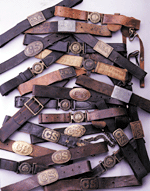
This private collection of rare buckles includes the original leather
straps.
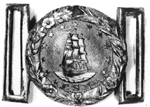
Waist belt plate of a Confedertae Navy officer,
ca. 1861-1865.
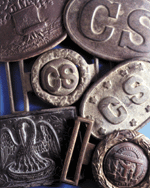
In recent years, it has become much easier to
reproduce Confederate
buckles and much harder to determine a fake from the authentic.

Waist Belt plate, CS two-piece,
ca. 1861-1865.
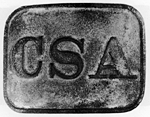
Round corner waist belt plate, CSA.
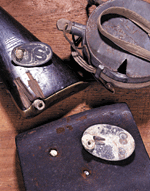
The value of Civil War items increases if they have been struck by
bullets.

A general officer's waist belt plate found in Oklahoma, ca. 1861-1865.
|